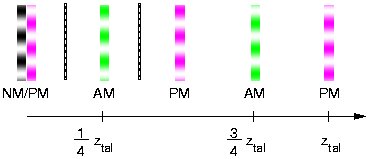Talbot Effect

The Talbot-effect is a near field ‘self-imaging’ effect generic for certain wave equations like the paraxial wave equation and the Schrödinger equation. Any spatial modulation of period Λ of a plane carrier wave is reproduced after the Talbot-length $z_R= 2Λ^2/λ$.

Moreover, starting with a pure phase modulation in a certain plane, after a distance of $z_T/4$ and $3z_T/4$ there are planes, in which the field has a pure amplitude modulation in first order.
Therefore, the resulting amplitude grating will be
- in phase with the original refractive index grating after a propagation by $z_T/4$. The resulting wavelength of the pattern in a focusing nonlinear medium is $Λ_{foc} = \sqrt{4λd} $.
- in anti-phase with the original refractive index grating after a propagation by $3z_T/4$ . The resulting wavelength of the pattern in a defocusing nonlinear medium is $Λ_{def} = \sqrt{4/3λd} $.
It should be cautioned that the real experimental system has two additional characteristic length scales in addition to the diffractive one given by the Talbot-effect. One is the diffusion length of the atomic motion. This will tend to suppress the instability for small wavelengths. The other is the overall size of the experimental system with is given by the diameter of the input beam.